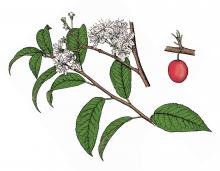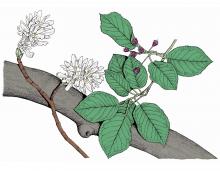Trees, Shrubs and Woody Vines
Media

Species Types
Scientific Name
Rhus glabra
Description
Colonies of smooth sumac are most noticeable in early autumn, because the leaves turn brilliant red! You can make drinks and jellies from the clusters of fuzzy red berries.
Media

Species Types
Scientific Name
Ilex opaca
Description
American holly is Missouri's most durable broad-leafed evergreen tree. It is best known for its bright red berries and spiny green leaves at Christmas.
Media

Species Types
Scientific Name
Rhus aromatica
Description
Unlike its cousin poison ivy, fragrant sumac is a peasant, nontoxic plant. Note the middle leaflet of its "leaves of three": On fragrant sumac, there is no (or at most a very short) leaf stalk on that middle leaflet. Also, fragrant sumac has hairy, reddish fruits (not waxy whitish ones).
Media

Species Types
Scientific Name
Various species in the genus Crataegus
Description
Our state flower, the hawthorn, is solidly represented in Missouri. There are about 100 different kinds of hawthorns that occupy almost every kind of soil in every part of the state. These members of the rose family are closely related to apples.
Media

Species Types
Scientific Name
Ilex decidua
Description
Possum haw, or deciduous holly, is the more common of two native Missouri hollies that lose their leaves each fall. This shrub or small tree is eye-catching in the fall and winter with its bright red berries.
Media

Species Types
Scientific Name
Prunus americana
Description
A shrub or small tree with clusters of white flowers in the spring, and small, edible, red or yellow fruits in mid- to late summer, wild plum is a popular tree for landscaping.
Media

Species Types
Scientific Name
Amelanchier arborea
Description
Downy serviceberry is a tall shrub or small tree found throughout Missouri in open or rocky woods. It is one of the earliest spring trees to bloom, producing showy white flowers. The springtime flowers, the purplish, often sweet berries, and the brilliant fall color make serviceberry an attractive landscaping tree.
Media

Species Types
Scientific Name
Malus ioensis
Description
Prairie crab apple is an attractive, small, ornamental tree with low, crooked branches and attractive spring flowers. Its hard, bitter fruits can be used in making tasty jellies, cider, and vinegar.
Media

Species Types
Scientific Name
Carpinus caroliniana
Description
American hornbeam is also called musclewood because of the sinewy appearance of its smooth gray bark. The name hornbeam refers to the genuine strength of its wood — it is one of the hardest and strongest woods in North America.
Media

Species Types
Scientific Name
Alnus serrulata
Description
Common alder is a good plant to know. The dried female catkins look like tiny pinecones.
See Also
About Trees, Shrubs and Woody Vines in Missouri
There are no sharp dividing lines between trees, shrubs, and woody vines, or even between woody and nonwoody plants. “Wood” is a type of tissue made of cellulose and lignin that many plants develop as they mature — whether they are “woody” or not. Trees are woody plants over 13 feet tall with a single trunk. Shrubs are less than 13 feet tall, with multiple stems. Vines require support or else sprawl over the ground.





















